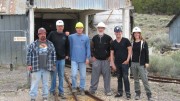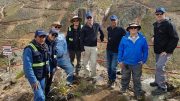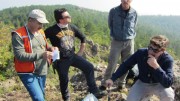The low gold prices of the mid-1980s forced the Atlanta gold mine in southeasten Nevada to close down. But remnants of the old mine still remain.
Atlanta is in Lincoln County, 250 km north of Las Vegas, and the nearest town is Pioche, 80 km south of the property.
Nestled atop a small hill overlooking the current field offices of Meadow Bay Gold (MAY-V), a fading, tin-panelled structure resembles an oversized barn more than a mill.
The silent, rusted machines inside attest to the activity of 25 years ago. A calendar in the old operator’s room reads June 1985 – marking the moment when workers packed up and left the hulking machinery on its own.
They didn’t know when they left that an orebody entirely different from the one they were mining lay just a few hundred metres north of the mill.
The area they had been mining, the Atlanta fault zone, has provided gold miners with material off and on since it was discovered in the 1860s, “presumably by former Confederate soldiers – otherwise, they would’ve named it the Boston deposit instead of the Atlanta,” Doug Oliver, Meadow Bay’s project manager, quips.
By 1910 miners on the property had sunk two shafts and mined down to 120 metres. That underground mine operated right up until 1950.
Unfortunately for historian types, mining in the then-remote part of Nevada was done with poor bookkeeping. No records of production were left.
This changed in the 1970s when a joint venture between Bobcat Exploration and Standard Slag built a small mining operation that ran between 1975 and 1985. The 800-tonne-per-day mill turned out a total of 110,000 oz. gold and 800,000 oz. silver from 1.5 million tonnes of ore.
But even then, the companies were content to keep a low profile in the little-explored region of Nevada, just a few kilometres from the Utah border.
Oliver found out about the mine by chance. It was 1977 and he was doing a uranium survey in the region for the federal government.
“One of the guys I was working with comes back one day and says he found a gold mine out there. So I asked him where it was exactly. The next day I set out to find it, and I found it,” he says. “They weren’t too happy to see me when I showed up, but eventually they told me a bit about what they were doing. I kept an eye on it ever since.”
And while he monitored the property, any attempts to acquire it were thwarted by an owner whose price seemed to rise dramatically every time Oliver went to talk to him.
Finally, a company named Desert Hawk contacted Oliver and told him they wanted to get a deal done. Oliver negotiated a price of $6 million, but Desert Hawk lacked the capital to close the acquisition. In stepped Meadow Bay, which acquired Desert Hawk in March and made the required payment in full.
At the time of the deal Meadow Bay believed it was acquiring a project with a well-defined mineralized zone – the Atlanta fault zone – and one with excellent infrastructure. The project has access to a power line and permitted water use from a well located just 16 km away. What it didn’t realize was that not long after the acquisition, the property would yield a gold-rich porphyry zone that had been missed by everyone else over the project’s long history.
After the Bobcat and Standard Slag operation ceased, the Atlanta mine sat idle for five years, until Gold Fields (GFI-N) came along in 1990 and drilled three core holes into the orebody.
It left shortly afterwards and Kinross Gold (K-T, KGC-V) arrived in 1997, showing more commitment to the ground.
The company drilled 80 reverse-circulation (RC) holes, which led to a non-compliant historical resource calculation of 9.3 million tonnes grading 1.7 grams gold and 2 grams gold equivalent for 464,500 oz. gold and 3.86 million oz. silver. But with gold prices falling in the late 1990s, it too packed up and left.
The only other company of significance to have a sniff was Atna Resources (ATN-T). Oliver says Atna thought it had a deal with the former property owner back in 2009, and in anticipation of getting the deal done, it staked the ground around Atlanta.
When the deal between the owner and Atna fell through, the company warmed to the idea of selling the ground surrounding Atlanta to Meadow Bay.
The two companies reached an agreement in June that will see Meadow Bay pay Atna $250,000 in cash and 400,000 in shares.
“We wanted the claims for a few reasons,” Oliver explains. “We needed the flat ground for a future mine. The Atlanta structure trends onto the Atna ground and they have a good geophysical target.”
The previous miners on the property missed that Atlanta was really the story of two different orebodies.
There was the Atlanta fault, with its mineralization occurring in a jasperoid fault breccia between overlying Tertiary volcanic rocks and Paleozoic sedimentary rocks. And then there was the unknown porphyry, deeper down and to the southwest of the historic Atlanta pit.
Standing at the edge of this pit, where the mineralized zone slices diagonally through the darker volcanic rocks on hangingwall side and the reddish sedimentary rocks on the footwall side, Oliver hypothesizes that the deposit was formed by multiple mineralizing events, each of which brought silica into the brecciated host rock. Sometimes that silica was associated with increased gold values and lower silver values, while at other times there was more silver and less gold.
The process repeated itself several times over millions of years, and left a mineralized zone that he describes as “monotonous.”
“It just keeps on going like the Energizer Bunny,” he says. “At every place we’ve drilled, if you go deep enough, you hit it.”
So far drilling has taken them 915 metres north of the historic pit, which is at the southern extension of the fault and 300 metres deep. Mineralization along the fault zone ranges in width from 18 metres to 30 metres.
The fault zone itself is covered by 10 metres of alluvium, beneath which the mineralized zone runs contiguously northwards.
And while Meadow Bay drills and plans more holes north to determine how far the zone runs, it is increasingly enticed by what it discovered earlier this year to the south of the pit.
An exploration hole drilled downdip and adjacent to the old Atlanta pit crossed thicker and richer mineralization in a different rock type. The hole returned 62 metres grading 1.63 grams gold.
“We started to get the feeling that this thicker part was not part of the volcanic rocks, but is actually a porphyry,” Oliver says of the discovery.
Once that realization was made, the entire geological model was re-envisioned.
“Everything started changing,” Oliver says. “We started to see the porphyry as a head engine that could be driving the mineralization in the fault.”
Two other holes were collared in the vicinity of the first and confirmed the first hole’s results, with one of the new holes striking the zone cleanly with an intercept of 64 metres grading 1.43 grams gold equivalent.
The third hole, which Oliver says was on the margin of the porphyry, still returned 35 metres grading 3.86 grams gold equivalent.
At this early stage the company doesn’t have a firm handle on the zone’s geometry, but says it is open to the west and to some extent, to the north and south.
“It’s always nice to get good surprises,” Oliver says of the discovery. “In this business, most of the time the surprises aren’t good. This was a nice surprise.”
What the discovery means for the project is that Meadow Bay may well have an unexpected, large-tonnage deposit in close proximity to the existing open pit.
The discovery is also motivating it to test out another geophysical anomaly that
mirrors the one registered where the porphyry was found.
Meadow Bay plans to drill 300 metres north of the northernmost drill holes along the Atlanta fault. The rock there will be tested with diamond drill cores first, so the geologists know what they are looking at, followed by an RC drill rig for infill and pre-collar drilling.
The company has budgeted for 20 diamond drill holes and 40 to 50 RC holes for 6,000 metres, and of course, the porphyry target will see its share of the drill bit.
Oliver says the exploration budget will be split in equal parts between testing the porphyry and the fault system.
The story will likely gather steam in the early part of next year, with Meadow Bay targeting a maiden resource estimate by the first quarter.
Coinciding with the estimate’s release will be the second phase of drilling, which will see another 12,000 metres drilled. A scoping study is expected to get underway by mid-2012.






Be the first to comment on "Meadow Bay bringing back Atlanta gold mine in Nevada"